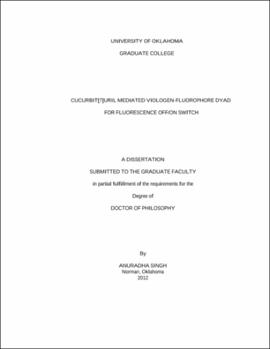| dc.contributor.advisor | Hlaterman, Ronald L | |
| dc.creator | Singh, Anuradha | |
| dc.date.accessioned | 2019-04-27T21:30:58Z | |
| dc.date.available | 2019-04-27T21:30:58Z | |
| dc.date.issued | 2012 | |
| dc.identifier | 99257584302042 | |
| dc.identifier.uri | https://hdl.handle.net/11244/318880 | |
| dc.description.abstract | CUCURBIT[7]URIL MEDIATED VIOLOGEN-FLUOROPHORE | |
| dc.description.abstract | DYAD FOR FLUORESCENCE OFF/ON SWITCH | |
| dc.description.abstract | Due to the advancement of fluorescence spectroscopy, fluorescence techniques have been applied in biological imaging and sensing. In biological imaging, biomolecules are labeled with fluorophore which allow us to track them. However, this procedure limits its implication where localized emission is stronger than the background one due to background fluorescence of nonspecific adsorbed fluorophore. Design of fluorescence-on binding sensors could be a better approach to overcome this disadvantage in which emission is quenched extensively until the sensing events occur. Our aim was targeted to develop the bright fluorescence probes by utilizing two different approaches: metal-enhanced fluorescence and photoinduced electron transfer. | |
| dc.description.abstract | To study the first approach it was necessary to obtain a well-ordered, good quality, high-density, and crystalline (√3x√3)R30o, corresponds to spacing in lattice, self assembled monolayer (abbreviated as SAM) on gold surface. We have developed a simple methodology for the generation of ordered SAMs by the cleavage of alkanethioacetate at bench top conditions. The extent of cleavage of decanethioacetate was investigated by the NMR spectroscopy experiments. The scanning tunnel microscope (STM) study was carried out on SAMs obtained in situ cleavage of thioacetate. According to the data obtained as a result of our investigations, a well ordered SAM was produced with the reagents that cleave thioacete fast and more complete within 2 h whereas slow cleavage of the thioacetate resulted in a poor ordered SAM. The developed methodology for obtaining well-ordered SAM was utilized to attach bodipy fluorophore on the gold surface. | |
| dc.description.abstract | The bodipy dye was incorporated to the gold surface by precleaving thioacetate tethered to bodipy with potassium hydroxide to investigate its optical properties. The gold/bodipy sol was stabilized by employing competing ligands. The molar fluorescence of bodipy on the gold nanoparticles was determined. In addition to this, the gold/bodipy sol was used to study ligand exchange on the gold surface. | |
| dc.description.abstract | As the second approach of our study, the photoinduced electron transfer was utilized to achieve fluorescence-on sensors. We were able to develop a novel and more general fluorescence-on signal unit in which the quencher tethered to fluorophore, dyad, switches from fluorescence-off to fluorescence-on state due to disruption of electron transfer from the excited fluorophore to the quencher upon binding of the latter with a host molecule, cucurbit[7]uril. The viologen-rhodamine B and viologen-bodipy dyads were synthesized to investigate their fluorescence off-on efficacy. According to our finding, complexation of CB7 with viologen caused 14 and 30 fold fluorescence enhancement of viologen-rhodamine B and viologen-bodipy dyad, respectively. | |
| dc.description.abstract | In continuation of the work towards the development of real time sensors, it was necessary to investigate the fluorescence off-on mechanism of dyads in the presence of competing binding molecules with CB7 at the different pH. For this purpose, we chose 1,4-diaminobenzene as it has lower pKa and comparable binding constant with viologen. It was observed that at lower pH, binding of CB7 with viologen as well as protonated diaminobenzene resulted in a small fluorescence enhancement. However, complete recovery of fluorescence was observed at higher pH because of complexation of CB7 with the viologen alone. | |
| dc.description.abstract | In conclusion, investigations were carried out for the development of next generation optoelectronic devices and novel real world applicable biosensors. | |
| dc.format.extent | 243 pages | |
| dc.format.medium | application.pdf | |
| dc.language | en_US | |
| dc.relation.requires | Adobe Acrobat Reader | |
| dc.subject | Fluorescence spectroscopy | |
| dc.subject | Fluorescence microscopy | |
| dc.subject | Biosensors | |
| dc.title | CUCURBIT[7]URIL MEDIATED VIOLOGEN-FLUOROPHORE DYAD FOR FLUORESCENCE OFF/ON SWITCH | |
| dc.type | text | |
| dc.type | document | |
| dc.thesis.degree | Ph.D. | |
| ou.group | College of Arts and Sciences::Department of Chemistry and Biochemistry | |
